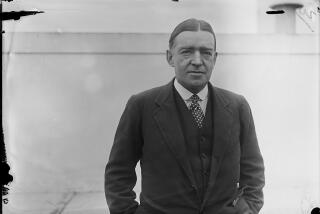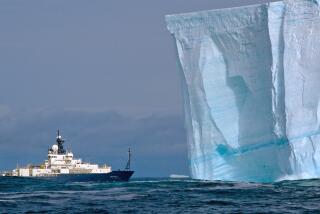I’m on top of the world, Ma
- Share via
Aboard the Akademik Ioffe — To escape the summer heat, my 14-year-old son, Edward, and I went north last year -- far north, by small cruise ship, to a high Arctic latitude. It proved to be the coolest vacation imaginable.
Indeed, gales and 4-foot snowdrifts from an Arctic blizzard delayed our charter plane’s departure for nearly a day. At last we left Ottawa for Nanisivik, near the northern tip of Canada’s Baffin Island, where the 110-passenger ship Akademik Ioffe awaited us.
We became further acquainted with the notorious changeability and potential harshness of weather in the high north, no matter what the season, when we neared the end of that six-hour flight and a dramatic charcoal-gray fog nearly forced us back. But our stalwart pilot plowed on, somehow finding a patch of blue through which to drop out of the sky and land on the snow-covered runway.
What followed were 10 days (and white nights) of alternately bleak and dazzling beauty. We saw ice-filled seas, glacier-lined shores and frozen landscapes populated by polar bears, orcas, harp seals and musk oxen.
Even on the most austere terrain, pockets of yellow and purple blossoms burst through the snow. Orange and green lichens speckled the rocks of forlorn beaches. Hiking across soggy ground, we saw the paw prints of animals hunting for food -- or being hunted themselves.
I went to the Arctic with Edward in hopes of finding an adventure that a middle-aged single mom and her teenage son could not just share but savor. I wanted to bond, to banter, to discover a venue that would lead us to exclaim in unison, “This is awesome!”
A brochure had arrived in the mail advertising small-ship cruises to the Canadian Arctic. The crisp color photos had called out to us: Icebergs! Wildlife! History! The lure of the vast north seemed irresistible.
After researching tour operators, we settled on Australia-based Peregrine Expeditions’ itinerary aboard the Akademik Ioffe, a Russian polar research vessel turned cruise ship. It promised hikes and on-board educational lectures (perfect for me) and motorized Zodiac raft rides and an open-bridge policy (sure to entertain Edward, the would-be mariner).
The route intrigued both of us: a retracing of voyages of explorers past who had sought the elusive Northwest Passage between the Atlantic and Pacific oceans. Conditions permitting, we were to cruise the waters along the coast of Baffin Island and the western coast of Greenland.
That was the back story to our arrival in Nanisivik, where we were greeted by light snow and temperatures around 30 degrees. We weren’t certain which bays, coves and inlets we would visit, partly because the route is always subject to icy conditions and other weather-inspired improvisations. What better way to begin an adventure?
Our accommodations, however, hardly constituted roughing it. Our simply furnished but comfortable cabin had room for two lower berths (each covered with a fluffy featherbed), armoires, sofa, small desk and private bathroom. The ship’s smaller cabins shared baths; more luxurious suites came with separate sleeping quarters. The windows to our cabin were too high for a good view, but it was easy enough to step on deck and be dazzled by the dappled spectrum of blue and green and chalky white hues in the procession of icebergs.
Warm bellies
On-board dining was equally appealing. Our daytime hikes along barren beaches and across the permafrost always led back to the ship in time for lunch and dinner. Those meals, as well as breakfast and afternoon tea, were served in a large dining room where frequent buffets and unassigned seating made it easy to meet and mingle.
A typical dinner began with minestrone soup followed by a choice of main courses: beef filet with mushroom sauce; mahi-mahi with fruit salsa and wasabi-flavored mayonnaise; poached salmon with spinach and garlic; or my choice one night, and a tasty one, a roasted vegetable crepe with tomato-basil sauce.
When nothing suited Edward’s taste, the chef prepared a highly satisfying grilled chicken breast.
There was always dessert as well as fresh bread, salad, fruit, and cheese and crackers. Mugs of hot tea, coffee and cocoa awaited us in the lounge whenever we returned, shivering, from a breezy, splash-filled raft ride or brisk walk on deck.
Such steamy warmth was particularly welcome because the temperatures didn’t hit 40 until we reached sunny Greenland, more than halfway through the trip. But why complain about the need for long underwear when a sizzling heat wave had hit back home?
From Nanisivik we plied northwest to Canada’s somber Beechey Island, site of the 1845 winter camp -- and last confirmed whereabouts -- of Sir John Franklin’s Arctic expedition. At the urging of Franklin’s widow, Lady Jane, 40 more expeditions searched for him. (Many of them also led to tragedy.) Experts still argue over why and how Franklin, one of the best Arctic explorers of his day, met his end. Bad navigation, inclement weather and tainted food are among suspected causes.
Wherever we stepped along the rocky beach, we found tiny seashells and even tinier traces of fossils embedded in the pebbles. Beyond the beach lies harsh, steep ledges -- terrain that is a legacy of the Ice Age.
The ship moved on to Dundas Harbour, on the coast of nearby Devon Island, which invoked a similar sense of remote splendor. The scattered bones and hair of a musk ox or caribou littered our path as we hiked to the abandoned shacks of what had been the northernmost outpost of the Royal Canadian Mounted Police.
Until 1932 two Mounties were stationed here for two-year stints and had for company only the occasional hunter and the crew of a supply ship that stopped once each year. Were such postings considered a punishment or a test of endurance?
As we made our way down the rocky slope, I noticed the black-and-green polka-dotted spongy lichen, the miniature mushroom caps, the soggy green-brown grass, red algae in a small stream and surprising blossoms coloring the landscape. Each bright spot in the harsh terrain struck me as a victory.
But Edward grew impatient.
“Mom, why are you so obsessed with the flowers?”
He warned me, as though he were a Mountie himself, that if I straggled too much I’d be mauled by a polar bear.
We had seen polar bears a couple of days earlier -- but not close up. We had reached 75 degrees north latitude, off Devon Island, when a 5:45 a.m. wake-up call urged us to grab binoculars and climb on deck. Polar bears could be spotted leaping from one piece of ice to the next, disappearing into the water, surfacing and rearing their heads to catch the scent of a seal or other prey -- all done with a grace and swiftness that belied their bulk.
Other wildlife delighted us too. One evening three orcas kept pace with our ship for half an hour, their rhythmic dives into the choppy water as smooth as any dance team’s. The day before, we had witnessed dozens of harp seals swirling in an apparent feeding frenzy in icy waters rich with small fish.
Most dramatic of all, off the migratory bird haven of Cape Hay, we encountered the sight, sound and smell of tens of thousands of long-winged, black-and-white Arctic birds. Thick-billed murres and kittiwakes squawked cacophonously from atop terraced cliffs. They hurtled down hundreds of yards toward the water, nearly splashing into our Zodiac below.
Lessons in adaptation
All these sights thrilled us -- and reminded us of how creatures have adapted to the polar climate. I couldn’t help but think how European explorers might have fared had they chosen to accept the expertise of the native Inuit.
At Baffin Island’s predominantly Inuit hamlets of Arctic Bay (population 700), about 20 miles east of Nanisivik, and Pond Inlet (population 1,000), we watched demonstrations of old traditions, including singing, dancing and sled-building, and saw a fashion show that centered on hand-sewn fur coats and boots. At dinnertime we feasted on delicious local Arctic char, just caught.
A Nanisivik lead, silver and zinc mine, which had provided work for many in Arctic Bay, had recently closed, unemployment was running high and the economic outlook seemed bleak. By comparison, Pond Inlet, its economy benefiting from its proximity to a government-funded national wildlife refuge, appeared to be thriving. Poverty and prosperity are familiar practically anywhere in the world, but the isolation of the high northern latitude made the contrasts seem more stark.
The Canadian north’s desolate beauty was so dazzling at times that after we crossed Baffin Bay and headed south down the western coast of Greenland, I was sorry to feel the temperature creeping up into the 40s, then the 50s. Yes, the bustling towns of Illulissat and Sisimiut were charming, but the sight of so much grass here -- the home of the world’s largest ice cap -- was startling.
Having grown to appreciate the quiet, icy allure of the far north, I was surprised to see a large cruise ship -- the Rotterdam of the Holland America line, with passengers in the hundreds -- moored in the very same Greenland ports we visited.
I asked Edward if he was having a good time. I had worried that, as the youngest passenger on board a ship that carried many retirees, Edward would miss the company of other teens. He didn’t.
“Mom, how could you possibly be bored on a trip like this?” he said.
In our self-selected group of polar enthusiasts, what mattered was the capacity to be open to the unknown and alive to nature’s wonder. That’s a lesson we’ll keep in mind as we plan next summer’s trip -- destination still to be determined.
*
(BEGIN TEXT OF INFOBOX)
Chilling out in the Arctic
THE CRUISE:
I booked my Arctic trip on the Akademic Ioffe last year through Expeditions Inc., based in Bend, Ore.; (888) 484-2244, www.expcruises.com. The company has a similar itinerary on the same ship with departure planned for late July. Prices for the 10-night cruise start at $3,690 per person, double occupancy, plus $925 per person for the mandatory charter flights between Ottawa and Nanisivik. Prices include all food aboard the ship and most excursions; drinks are extra, as are optional kayaking trips ($350). Passengers arrange their own transportation to and from Ottawa; Air Canada, American, Continental and US Airways offer connecting service (change of planes) from Los Angeles, and restricted round-trip fares start at $333.25.
Several other agencies specialize in small-ship travel to the Arctic. You also can contact cruise lines directly. They include New York-based Lindblad Expeditions, (800) 397-3348, www.expeditions.com; Connecticut-based Quark, (800) 356-5699 or (203) 656-0499, www.quarkexpeditions.com; Missouri-based Clipper Cruise Line, (800) 325-0010 or (314) 655-6700, www.clippercruise.com; and Australia-based Peregrine Adventures, 011-61-3-9663-8611, www.peregrineadventures.com.
TO LEARN MORE:
Canadian Tourism Commission, (213) 346-2700, www.travelcanada.ca.
-- Diane Cole
Diane Cole is the author of the memoir “After Great Pain: A New Life Emerges” (Winedale Publishing). She lives in New York.
More to Read
Sign up for The Wild
We’ll help you find the best places to hike, bike and run, as well as the perfect silent spots for meditation and yoga.
You may occasionally receive promotional content from the Los Angeles Times.






